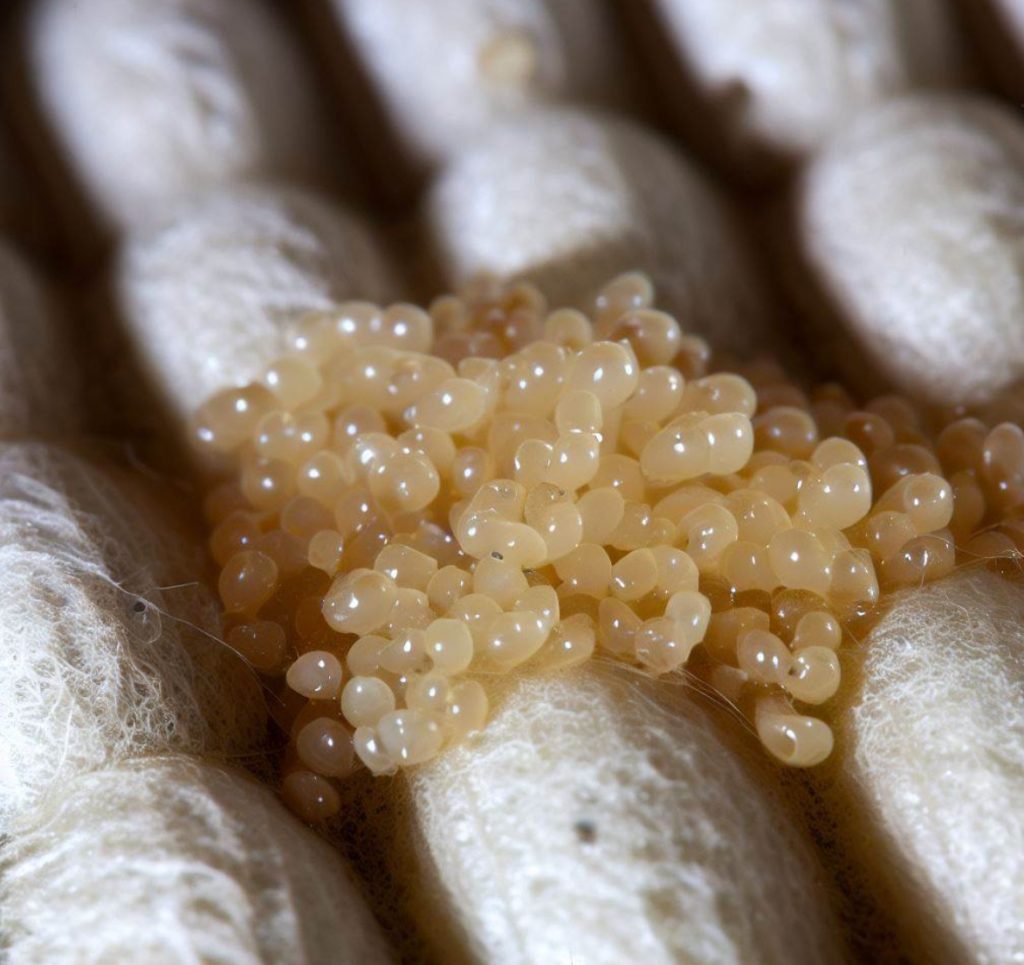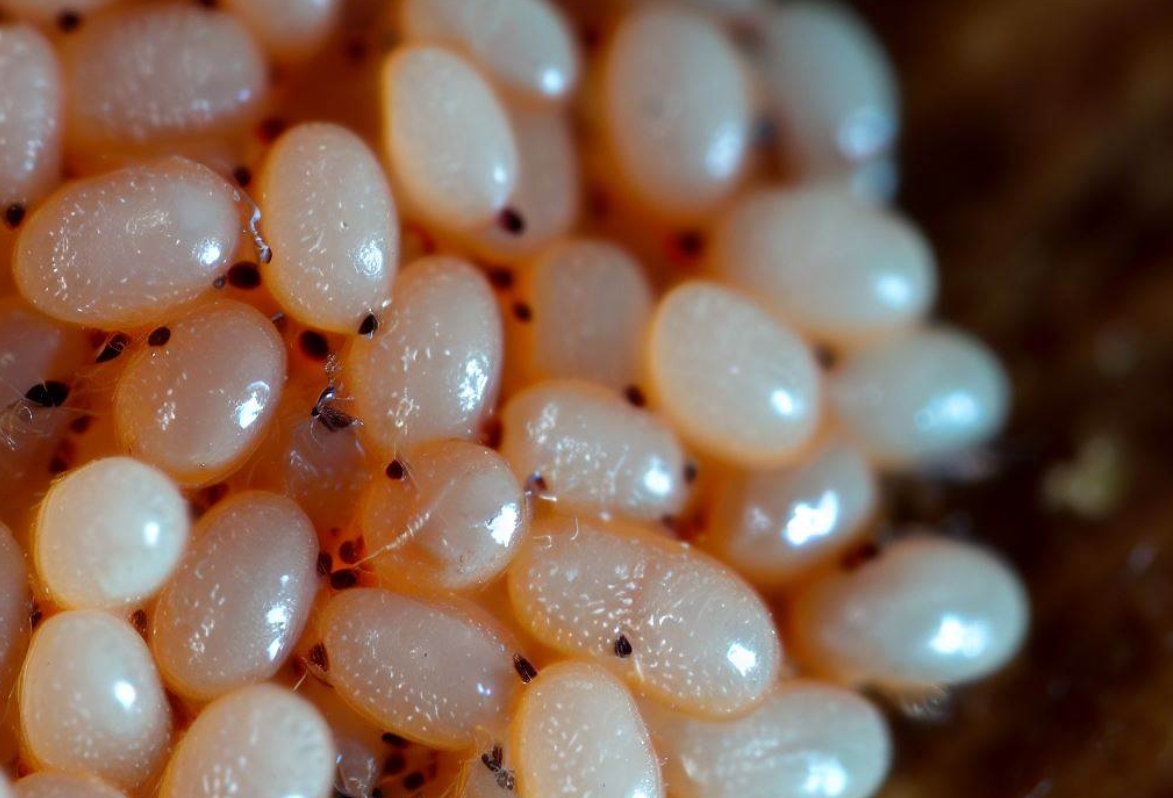Have you ever tried to find a needle in a haystack? Looking for bed bug eggs is kind of like that, only harder. Because, unlike needles, these eggs are masters of camouflage. But what do these elusive eggs really look like?
Bed Bug Eggs at a Glance:
Contents
| Characteristic | Description |
|---|---|
| Size | Very small, about 1 millimeter or the size of a pinhead |
| Color | White or pearl-white |
| Shape | Elongated oval |
| Appearance | Translucent, resembling tiny grains of rice or salt |
| Clustering | Often laid in clusters |
| Hinged Cap | A hinged cap at the front end that opens for the nymph to emerge |
| Location | On or near beds, mattress seams, furniture, behind headboards, cracks and crevices, walls, baseboards |
| Hatch Time | Within seven to 10 days |
| Markings | Dark mark resembling an eye if more than five days old |
But, let’s dive a bit deeper…
Details That Matter:

Remember that hinged “cap” I mentioned earlier? It’s like a little door from which the baby bed bugs (called nymphs) will emerge. Imagine a miniature spaceship door, but for bugs. Eerie, right?
And those clusters? Think of them like a bed bug nursery. Because why lay one egg when you can lay several at once, right? That’s what the female bed bug thinks, especially when she finds that perfect spot right next to a meal (yes, that would be us!).
Did you know? A female bed bug can lay hundreds of eggs in her lifetime. That’s like having a full kindergarten class… of bugs.
Hide and Seek: Where Do They Lurk?
When was the last time you checked the crevices of your bed frame or the folds of your mattress? If you’re like most people, probably never. And that’s exactly what bed bugs count on. They adore those secret little nooks, especially if they’re as thin as a business card. So, the next time you’re hunting for these eggs, think like a detective. Where would you hide if you were a bed bug?
Top 5 Locations to Check:
1. Mattresses: It’s no surprise, given that they love staying close to their food source (yep, that’s you). Those cozy seams and joints of your mattress are prime real estate for them. They offer the bugs darkness, safety, and quick access to a midnight snack.
2. Furniture: Imagine settling into your favorite chair, only to discover you’re not the only one who finds it comfy. Couches, chairs, and other upholstered items become ideal spots for these pests.
3. Cracks and Crevices: The size of a business card might seem thin to us, but for a bed bug, it’s a spacious abode. This adaptability means they can sneak and lay their eggs almost anywhere, from the gaps in your bookshelf to the crevices of a picture frame.
4. Baseboards and Floorboards: Not just content with the horizontal spaces, bed bugs will venture to vertical territories, setting up shop in places like walls and baseboards. This makes them especially hard to spot and remove.
5. Behind Headboards: Close to their favorite diner (yes, still you) and safely hidden from plain sight, the space behind headboards becomes an ideal nesting spot.
How to Get Rid of Bed Bug Eggs
No one wants their home to become a playground for pests, especially not bed bugs. If you’ve spotted bed bug eggs, it’s game time. Luckily, there are multiple ways to combat these pesky invaders. Let’s dive into some of the most effective strategies:
1. Turn Up The Heat 🌡️:
- Heat Treatment: Giving your belongings a hot bath might be all you need. Washing items in hot water (of at least 120°F or 49°C) and then putting them in a dryer set to high heat can send those eggs packing1. Think of this method as a spa day, but for your linens and not the bugs!
- Steam Cleaning: If you’ve ever enjoyed a steamy sauna, you’ll appreciate this method2. Using a steam cleaner on your furniture and mattresses will not only freshen them up but also exterminate those pesky eggs.
2. Suck ‘Em Up 🌀:
Vacuuming: Let your vacuum cleaner become your best ally. A thorough sweep of infested areas, especially those tight nooks and crannies, can help pick up bed bug eggs3. Just remember to dispose of the vacuum contents outside your home immediately.
3. Scrub-a-Dub-Dub 🪥:
Scrubbing: Time to flex those muscles! Using a stiff brush to give infested areas a good scrub can knock those eggs loose4. While this may not remove every single egg, reducing their numbers is always a step in the right direction.
4. Chemical Warfare 🧪:
Chemical Treatments: There are treatments available that can target bed bug eggs. However, no chemical is a silver bullet1. If opting for this, make sure to follow the recommended application methods and intervals.
5. Call in the Big Guns 📞:
Professional Extermination: Sometimes, it’s best to admit when we’re outmatched and call in the experts2. A professional exterminator will come equipped with advanced treatments and a game plan to ensure every last egg (and bug) is dealt with.
Finally, remember that prevention is better than cure. Consistent inspections, good hygiene, and being cautious when traveling or bringing in second-hand furniture can make all the difference in the world. After all, isn’t it better to keep the enemy out rather than deal with them once they’ve settled in?
FAQs
How many eggs can a bed bug lay at once?
Bed bugs lay their eggs in clusters, and a female can lay between 1 and 7 eggs per day depending on conditions and food availability. In her lifetime, she may lay up to 500 eggs. These eggs are often deposited in tight cracks or crevices, making them challenging to detect.
How long do bed bugs typically live?
The typical lifespan of bed bugs is 3 to 12 months, but it can vary. They can lay dormant for up to a year in ideal conditions without food. In optimal settings, an adult bed bug will feed every 7 to 10 days. Nymphs might go months without feeding, while adults can survive up to a year without a blood meal. They progress from egg to nymph to mature adults and can reproduce quickly.
What are some signs of a bed bug infestation?
- Bites on the skin
- Blood stains on bedding
- Fecal spots resembling ink stains
- Shed skins and eggshells
- Musty odor
- Visual sightings of bugs
How long does it take for bed bug eggs to hatch?
Bed bug eggs typically hatch in 6 to 10 days. They’re oval, white, and about 1/16” long. They’re laid in clusters in hiding spots and are hard to spot due to their translucent appearance.
How many bed bug eggs can be laid at once?
A female bed bug can lay up to 7 eggs at once and can produce between 4 to 7 eggs daily. Over her lifetime, she might lay over 200 eggs.
Do bed bug eggs pose a health risk?
While the eggs themselves don’t, their presence indicates an infestation which can have health implications. This includes allergic reactions, secondary infections from scratching, mental health impacts, and general discomfort.
How can I prevent bed bugs from infesting my home?
- Inspect secondhand furniture
- Use protective mattress covers
- Reduce clutter
- Seal cracks and crevices
- Vacuum regularly
- Wash and dry clothes and bedding in hot water and high heat
- Be cautious when traveling
- Use bed bug traps
- Consider professional pest control
Can bed bug eggs survive in the washing machine?
Bed bug eggs can’t survive in hot water in a washing machine. The heat and agitation will kill them. However, cold water might not be as effective. For best results, use hot water (above 120°F or 49°C), detergent, and dry on high heat for at least 30 minutes.
